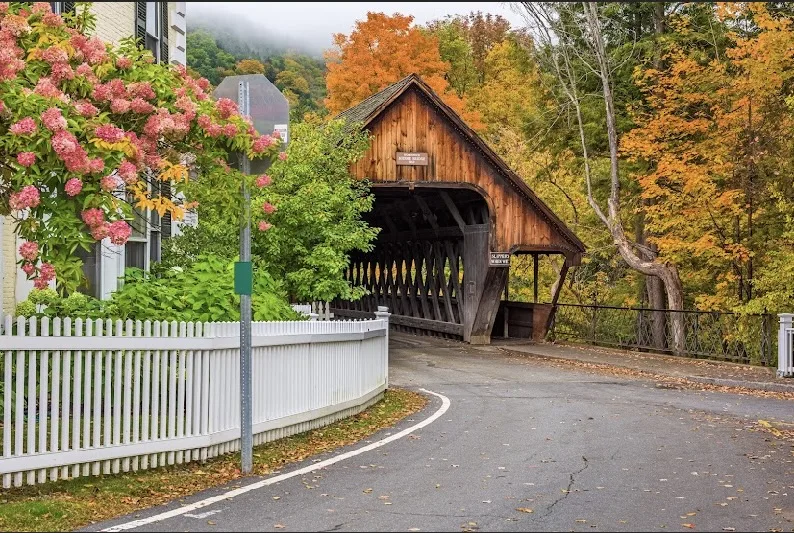My seven-year-old Ross and I peered over the railing and down into the slate blue water of the St. Lawrence River. “There, it’s coming up on the bow,” our tour guide, Nancy, announced. We strained to spot something, anything. A shipwreck maybe? A sea monster? “Now! We’re passing right over it,” Nancy beamed. “Over what?” I asked my husband Peter, who sat on the bench of the tour boat as Ross and I stared into the water, the other passengers beside us at the rail. “Did you see it?” Nancy asked, and then chuckled into her microphone. “Don’t feel embarrassed. It was the international boundary between the United States and Canada, and of course, there’s nothing to see!” Sheepishly I returned to my seat, wondering how Peter figured out we were setting ourselves up for a practical joke. Not me — Nancy got me, hook, line and sinker! But that kind of fun is just part of what attracts a multitude of vacationers to the Thousand Islands every summer.
Water, water everywhere This group of almost 2,000 islands is found near the mouth of the St. Lawrence River, about 200 miles northwest of New York City. The St. Lawrence, North America’s longest east-west river, flows from Lake Ontario 800 and some miles to the Atlantic Ocean, providing an important passage for ocean freighters to reach the Great Lakes. Scattered for about 60 miles along the river between New York and Ontario, the Thousand Islands offer vacationing families an array of activities, most of which involve water. I’ve been fortunate to enjoy the ambience of the Islands since I was a little girl. I grew up summering on Hill Island, where my great aunt Adelaide’s Victorian cottage proved a gathering spot for our extended family. I hiked all over the island, rowed our wooden boat in the cove near the cottage, fished for perch in the stillness of the boathouse, and escaped from normal life for a while. While those days seem long ago, the ability to escape from the hectic pace of everyday life still draws people to the Thousand Islands. It’s a place where natural beauty, fresh air, brisk water, and brilliant sunsets make you appreciate being alive.
The rich and famous One of the best introductions to the Islands is a boat tour. Many are available, some offering buffet meals and entertainment. My family and I enjoyed the two-hour, two-nation tour offered by Uncle Sam Boat Tours, which departs daily during the summer months from Alexandria Bay. On the tour you’ll hear the history of the region, as well as pirate legends and stories of the rich and famous who have vacationed there since the late 1800s. Among them was George Boldt, who managed two prominent hotels in the late 1800s: the Waldorf-Astoria in New York and the Bellevue-Stratford in Philadelphia. As a testimony of love for his wife, George decided to build a Rhineland castle on a heart-shaped island near Alexandria Bay. Work on Boldt Castle began in 1897, but in 1904 when the castle was nearly finished, George told the 300 builders and craftsmen to stop work. His beloved wife had died of pneumonia at the age of 42. The castle remained untouched for decades, until 1977, when it was acquired by the Thousand Islands Bridge Authority, which has since undertaken a massive rehabilitation program to restore it to its original beauty. We enjoyed exploring the castle’s four stories and myriad rooms, some of which are lavishly restored and decorated with Italian marble floors and walnut paneling. Historic photographs and period furnishings are on display in rooms that are finished. Others are still in a state of disrepair. Ross liked the Alster Tower, also called the Play House, a playful structure right on the water with, among other things, a two-lane bowling alley. I loved the formal Italian garden on the opposite side of the island, with its marble statues, some of which were found still crated where they had sunk in an old boathouse.
A sense of the past A sense of the past is prevalent here, where the rocky bluffs that edge the islands are estimated to be a million years old. This granite is all that remained when mile-thick sheets of ice, known as the Great Canadian Shield, melted at the end of the Ice Age. Ice still forms each winter on the St. Lawrence and can grow thick enough to support cars and trucks. Thousand Island salad dressing did in fact originate in the Thousand Islands. A steward served George Boldt a new dressing while cruising the river, and George liked it so much he named it after his favorite vacation destination and served it in the restaurants of his world-famous hotels. After our boat tour, Peter, Ross, and I visited Clayton, a riverfront town just a short drive from Alexandria Bay, which boasts antique shops, a few restaurants, and a fabulous playground, perfect for letting kids burn off some energy. Another reason to visit Clayton is the Antique Boat Museum, home of wooden boats of yesteryear. The boats range from luxurious run-abouts with leather upholstery to simple St. Lawrence skiffs with their signature pointed sterns, resembling canoes more than rowboats. Seeing these boats brought back memories of riding in Adelaide’s Chris Craft back and forth from our cottage to Rockport, Ontario, the closest village on the mainland. Rockport remains a charming town with a winter population of 50 that swells to 1000 in the summer.
Island heritage Just downriver from Rockport on the Canadian side is the town of Gananoque. With its old-fashioned main street lined on both sides with shops and restaurants, “Gan”, as we called it, is a pleasant town to explore. Families will especially enjoy stopping in the Arthur Child Heritage Centre, a museum dedicated to showcasing the history of the Thousand Islands region, and lunching on the outside terrace of the nearby Gananoque Inn. Another destination is Upper Canada Village, about an hour’s drive east near Cornwall, Ontario. A recreated pioneer village spread out along the riverfront is peopled with docents who welcome you into their homes, barns, shops, and gardens. It’s an educational outdoor history museum with lots for kids to do, such as milking a cow, playing old-fashioned games, riding in a horse-drawn wagon, and learning about Canadian life in the 1860s.
Accommodations in the Thousand Islands range from mom-and-pop motels to luxury hotels. Families can also rent homes in the Islands or camp in one of the many state and national parks in the vicinity. Another unique option for a truly nautical experience is to rent a houseboat and sleep on the river. When you visit, make sure you take time to walk in the pine-scented woods, watch a salmon-pink sunset, and listen to the loons calling across the river. For more information, call 1-800-847-5263 or visit www.visit1000islands.com.





















